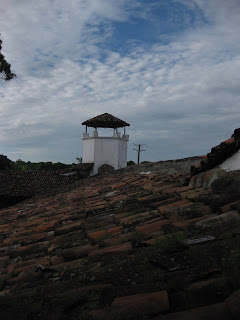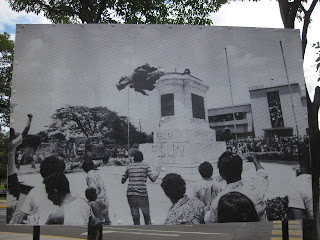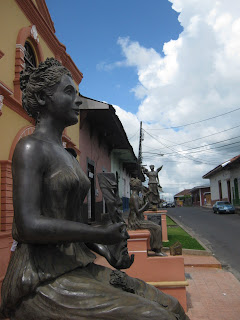






Both the World Series and Día de los Muertos came upon us in Granada. We found the Nuevo Centro, a congenial bar, to watch games 4 and 5. At the cemetary we found many families renovating their loved ones' graves, fierce competition among the flower sellers, and a few big bands blowing jazz numbers graveside.








In the Doña Elba cigarreria we got to know dueño Silvio Reyes, his macaw, and his stories about customer Schwarzenegger, the taller figure nearly visible in that photo above the counter.



At last we dragged ourselves away from the great bread (whole wheat! not white and fluffy!) and pizza at El Bendito and took a bus to Managua. The word Managua has a ludicrous magic for me, bruited about as it was in my formative years. We heard on all fronts that among the myriad "dangerous" places to go in Latin America, Managua lived up to the reputation. Apparently even the police won't go near, of all places, Parque de la Paz. The hostel we chose was ringed by razor wire and impossible to penetrate without the say-so of the formidable Doña Angela. It was also 2 blocks from the spotless and tasty Cafetin Mirna. Our cabdriver from the bus stop had proven himself to be both honest and nice and we asked him to take us on a tour of the city's historic highlights.
The old city center of Managua, built on a faultline, was destroyed in an earthquake in 1972 and never rebuilt. On the old Plaza de la Republica, now the Plaza de la Revolucion, the old cathedral is still standing. Giant billboards of President Ortega that commemorate the 30th anniversary of the overthrow of the Somoza regime are everywhere in the city, as are representations of Agusto Sandino. A park in front of the baseball stadium has a statue of Sandino on a burro that replaced one of Somoza on horseback torn down in the revolution. The hindquarters of the Somoza horse are cheekily preserved in a little pen across the street in a park devoted to giant captioned photos from the revolution. We checked these out on our tour as well as the new cathedral that looks a lot like an egg carton and prehistoric footprints preserved in volcanic mud and discovered by workers in the 19th century.












Our evening in Managua fell on game 6 of the World Series and we planned to watch it in a little Irish pub in the neighborhood. The Shannon was closed so we adjourned to a "buffet" to watch the game. In the course of the Phillies' thrashing we fell into conversation with Michael who turned out to be the Irish expat owner of the Shannon, or maybe not. We passed the evening with him and his friend Rafael, an appellate court judge.
Michael told us several incredible stories. One involved a program to bring together the wives of republicans and loyalists jailed during the Troubles, and their eventual bonding discussing the indignities of conjugal visits. Others involved his time in Honduras and El Salvador in the '80s. Most of these had to do with charity work but he also mentioned assistance to the rebels involving things an Irish Republican might know something about. Finally, just before telling us that his name was not really Michael and disappearing, he swore that thirty percent of the weapons that the U.S. was secretly sending to the Contras, funded through secret arms sales to Iran, were being sold to the FMLN rebels fighting the U.S. supported government in El Salvador. We were left to wonder what was real amid the ruins of Managua.
Our final stop in mid-Nicaragua was León, birthplace of national treasure, poet Rubén Darío. There are lions everywhere in the city including one weeping at Darío's tomb. León feels like a real place, more than Granada which is unabashedly tourist oriented. We loved exploring its neighborhoods and took one day at a nearby beach, Las Peñitas.


































In León we stayed one night in a flophouse and then Mike insisted that we move somewhere more comfortable where I could get rid of a wretched sore throat and incipient cold. La Casona Colonial is a lovely place, run by Rosario who raised her children in Guatemala. Her son opened the hotel in the family's old home in León and then was killed in an accident. Rosario moved back to run the business. It struck me as horribly sad, that she had kept her kids out of harm's way during the war only to have her beloved son killed randomly back in Nicaragua. There was a beautiful photo of her sister on the wall, a young woman with a remarkably strong face who went on to become a nun. Rosario's strength, though not her sadness, is echoed in her sister's face.

Here is a beautiful poem that Mike wrote about Rosario.
Hotel en León
Estoy aquí en este comedor,
casi silencioso excepto para
los estallidos ocasionales de
los fuegos artificiales afuera.
Me sento debajo de la mirada
amable y fija y enmarcada
de un hombre guapo y muerto,
el hijo de nuestra mesonera.
"Era su lugar," Rosario dijo
sonriendose con lágrimas
y yo pensé que en Nicaragua
haga pocas cosas nuevas.
Cosas nuevas que puede ayudarte
olvidar todo que es perdido.

No comments:
Post a Comment